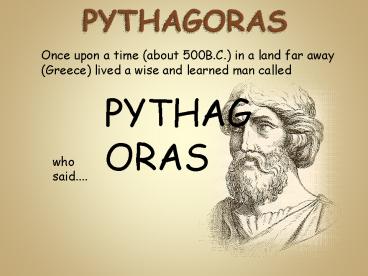FUN WITH PYTHAGORAS - PowerPoint PPT Presentation
1 / 36
Title:
FUN WITH PYTHAGORAS
Description:
LET'S LABEL THE SIDES OF THE TRIANGLES a, b AND c WHERE, FROM OUR DEFINITION, c ... AREA OF TRIANGLE abc = x a x b = 1/2ab. AREA OF SMALLER SQUARE = c x c = c ... – PowerPoint PPT presentation
Number of Views:90
Avg rating:3.0/5.0
Title: FUN WITH PYTHAGORAS
1
FUN WITH PYTHAGORAS
Once upon a time (about 500B.C.) in a land far
away (Greece) lived a wise and learned man called
PYTHAGORAS
who said....
2
FUN WITH PYTHAGORAS
- In a right-angled triangle,
- the SQUARE on the HYPOTENEUSE is equal to
- the SUM of the SQUARES on the OTHER TWO SIDES
OR
A
A B C
B
C
SO WHAT?
And the people all said....
3
FUN WITH PYTHAGORAS
Well, it must be important or we wouldnt still
be talking about it after more than 2,500
years! And it doesnt take a genius to see that,
if you know the length of two sides of a
right-angled triangle, you can calculate the
length of the third side by using Pythagorass
theorem. This has uses in navigation, cartography
(map making), astronomy, design and construction,
etc. And it is fundamental in the development of
trigonometry and geometry. The thing is that,
before we can just accept it, we really ought to
prove that it works...
4
FUN WITH PYTHAGORAS
Firstly, lets check what we mean by a
right-angled triangle...
HYPOTENEUSE
ONE ANGLE IN THE TRIANGLE MUST BE 90 THE SIDE
OPPOSITE THE RIGHT ANGLE IS CALLED THE HYPOTENEUSE
NOW LETS SEE IF WE CAN PROVE WHAT PYTHAGORAS
SAID ABOUT THE SQUARES...
90
5
FUN WITH PYTHAGORAS
DRAW A SQUARE
6
FUN WITH PYTHAGORAS
DRAW A SECOND SMALLER SQUARE INSIDE THE FIRST AND
HAVING THE SAME CENTRE.
7
FUN WITH PYTHAGORAS
NOW ROTATE THE SMALLER SQUARE ABOUT ITS CENTRE
UNTIL ITS CORNERS TOUCH THE SIDES OF THE LARGER
SQUARE
8
FUN WITH PYTHAGORAS
9
FUN WITH PYTHAGORAS
10
FUN WITH PYTHAGORAS
11
FUN WITH PYTHAGORAS
12
FUN WITH PYTHAGORAS
AS YOU CAN SEE, WE HAVE CREATED 4 TRIANGLES AND,
BECAUSE THE CORNERS OF THE SQUARES ARE RIGHT
ANGLES, THE TRIANGLES ARE ALSO RIGHT-ANGLED.
13
FUN WITH PYTHAGORAS
LETS LABEL THE SIDES OF THE TRIANGLES a, b AND c
WHERE, FROM OUR DEFINITION, c IS THE HYPOTENEUSE
c
b
a
14
FUN WITH PYTHAGORAS
IN FACT, WE CAN LABEL THE SIDES OF ALL 4 TRIANGLES
b
a
b
c
a
c
c
a
c
b
a
b
15
FUN WITH PYTHAGORAS
SIDE OF LARGE SQUARE a b AREA OF LARGE SQUARE
(a b) x ( a b) a² 2ab b²
b
a
b
c
a
c
c
a
c
b
a
b
16
FUN WITH PYTHAGORAS
AREA OF TRIANGLE abc ½ x a x b 1/2ab AREA OF
SMALLER SQUARE c x c c² TOTAL AREA OF 4
TRIANGLES SMALLER SQUARE 4 x 1/2ab c²
2ab c²
a
b
b
c
a
c
c
a
c
b
a
b
17
FUN WITH PYTHAGORAS
FROM PREVIOUS TWO SLIDES TOTAL AREA OF LARGE
SQUARE a² 2ab b² 2ab c² REMOVING 2ab
FROM BOTH SIDES, a² b² c²
a
b
b
c
a
c
c
a
c
b
a
b
18
FUN WITH PYTHAGORAS
BUT c² IS THE SQUARE ON THE HYPOTENEUSE AND a²
AND b² ARE THE SQUARES ON THE OTHER TWO SIDES
JUST AS PYTHAGORAS SAID!
a
b
b
c
a
c
c
a
c
b
a
b
19
FUN WITH PYTHAGORAS
BELIEVE IT NOT, SINCE PYTHAGORAS POSTULATED HIS
THEOREM, OTHER PEOPLE HAVE DEVISED IN EXCESS OF
500 PROOFS.
HERES THE NEXT ONE...
20
FUN WITH PYTHAGORAS
DRAW A RIGHT-ANGLED TRIANGLE
21
FUN WITH PYTHAGORAS
CONSTRUCT THE SQUARE ON ONE SIDE
22
FUN WITH PYTHAGORAS
THEN ANOTHER
23
FUN WITH PYTHAGORAS
AND FINALLY THE THIRD
24
FUN WITH PYTHAGORAS
CONSTRUCT A LINE PARALLEL TO ONE SIDE OF THE
HYPOTENEUSE (BLUE) SQUARE SO THAT IT PASSES
THROUGH THE CENTRE OF THE SECOND (RED) SQUARE
25
FUN WITH PYTHAGORAS
THEN A SECOND LINE PARALLEL TO THE OTHER SIDE OF
THE BLUE SQUARE ALSO PASSING THROUGH THE CENTRE
OF THE RED SQUARE
26
FUN WITH PYTHAGORAS
CUT THE RED SQUARE INTO FOUR AS INDICATED BY THE
LINES JUST DRAWN
1
27
FUN WITH PYTHAGORAS
CUT THE RED SQUARE INTO FOUR AS INDICATED BY THE
LINES JUST DRAWN
2
28
FUN WITH PYTHAGORAS
CUT THE RED SQUARE INTO FOUR AS INDICATED BY THE
LINES JUST DRAWN
3
29
FUN WITH PYTHAGORAS
CUT THE RED SQUARE INTO FOUR AS INDICATED BY THE
LINES JUST DRAWN
4
30
FUN WITH PYTHAGORAS
SLIDE THE SECTIONS INTO THE BLUE SQUARE
31
FUN WITH PYTHAGORAS
32
FUN WITH PYTHAGORAS
33
FUN WITH PYTHAGORAS
34
FUN WITH PYTHAGORAS
AND FINALLY SLIDE THE SMALLEST SQUARE INTO THE
HOLE REMAINING IN THE LARGEST SQUARE
WE HAVE NOW TRANSFERRED THE SQUARES FROM THE
SMALLER TWO SIDES ONTO THE SQUARE ON THE
HYPOTENEUSE, ONCE AGAIN PROVING THAT...
35
FUN WITH PYTHAGORAS
- In a right-angled triangle,
- the SQUARE on the HYPOTENEUSE is equal to
- the SUM of the SQUARES on the OTHER TWO SIDES
36
FUN WITH PYTHAGORAS
- In a right-angled triangle,
- the SQUARE on the HYPOTENEUSE is equal to
- the SUM of the SQUARES on the OTHER TWO SIDES

